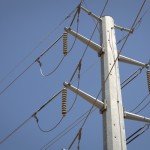Why a Truly ‘Green’ Car Race Might Not Be Possible for Formula One

Photo by Clive Rose/Getty Images
A Red Bull Racing car wins the Korean Formula One Grand Prix in October.
Three model cars sit side-by-side on the windowsill of Zach Baumer’s office in East Austin, memories of a childhood spent with his family at Indy 500 races.
“Growing up in Indianapolis, I just have sort of a thing for cars,” he says. “Not that I think we should be driving single occupancy vehicles! But … it is what it is.”
There’s a reason Baumer might sound quick to qualify his fondness for horsepower and tight turns. As manager of the city’s Climate Protection Program he’s in charge of mitigating the environmental impact of another well known car race taking place in Austin this fall: the Formula One Grand Prix.
The history of Texas and Formula One is a long and tangled one. State lawmakers laid the groundwork for bringing the race to Austin in 2009, when they passed a law allowing tax subsidies to help finance the event. But things got complicated when the City of Austin was approached to pony up some of its own subsidies. With Austin’s city council divided on whether to welcome the race, F1 organizers agreed to sweeten the deal. In what they called a first-of-its-kind partnership, they agreed to make Formula One ‘greener.’
That’s where Baumer and his team come in. Their job is to work with race organizers and environmental groups to calculate and mitigate as much of the environmental impact of the race as possible. And that involves some tricky arithmetic.
First, you have to figure out what’s using up resources.
“So there are on-site generators that will be used, there’s electricity that will be used, there’s food, there’s waste, there’s water that’s used,” says Baumer. “Then there’s the race cars actually going around the track using fuel.”
Then the real challenge in figuring out how to offset emissions comes outside the track. Some 120,000 people are expected to attend the race. That means more cars on Texas roads, more AC units running, more lights being turned on and off, and more flights in and out of the airport. All of which requires additional power.
“We know that there is some carbon footprint to travel to Austin, and chances are that that’s substantial enough that the real need is how to offset at least some of that, if not all of it,” Colin Meehan, with the Environmental Defense Fund, tells StateImpact Texas.
Under its contract with the City of Austin, race organizers agreed to limit cars traveling to and from the race by having visitors take shuttles. The event is recycling and composting at the track, and has even ponied up money for research and development in green energy. As part of a commitment to making the race carbon-neutral, Baumer says race organizers agreed to pay $15,000 to purchase carbon offsets.
“You know, right now if we were to go out and go on the internet and buy carbon offsets, we could buy offsets for maybe $10 a ton [of carbon] or less. So if it’s $15,000, divide that by ten, and that would only be about 1,500 tons,” Meehan says.
And that’s not likely to put a major dent in the carbon footprint of the event. Why? It all goes back to those visitors flying in.
About 100,000 people are expected to come in from out-of-state for the race. Some of those will be flying domestically, and others will come in from places like Brazil, China, and France. According to carbon calculators, a single traveler from Paris with one layover will cause over two tons of carbon emissions just by flying. All told, about 80 extra flights are expected to come through the city just because of the race. So even before the race begins, air travel alone could be responsible for thousands of tons of emissions, well above the carbon offsets Formula One is purchasing.
Red Bull’s F1 Team celebrates the race’s arrival by doing donuts at the Texas State Capital
It’s a fact that illustrates one of the major challenges for any carbon offset system. Exactly where do you draw the line for the pollution you want to be responsible for? In the case of Formula One, it’s left race organizers open to charges of “greenwashing” from some environmental groups.
“Most of the [race organizers] concessions were limited in terms of money or scope, and were designed primarily to give it a green tint without really getting to the fundamental issue: That the enormous amount of pollution from this will have significant economic impact to the City,” Tom “Smitty” Smith, director of the environmental group Public Citizen tells StateImpact Texas.
But Zach Baumer with the City of Austin says the current carbon offset commitments are “more than nothing.” He sees progress in the fact that the race organizers have hired a full-time employee to monitor the environmental impact.
And Austin is already reaching out to other big events, like South By Southwest and Austin City Limits to try to create similar partnerships.
Update: The Formula One race is almost upon us, and the number of extra planes flying in to Austin has increased, along with their carbon emissions. As of Monday, Austin Bergstrom International Airport expected 150 extra aircraft, says airport spokesperson Jim Halbrook.
“The aircraft range in size greatly, from propeller-driven Cessnas to more of your business-style jets, to really large charters such as 747s and 767s,” he tells KUT News.
You can add at least one more plane to that list: an EPA Aero Command 680. It will be flying low over the event to monitor the air quality. No, it wont be looking for carbon emissions, it will be testing for evidence of radiological waste. The Department of Homeland Security says it does this at big events in order to detect the presence of a terrorist “dirty bomb.”
Now that’s one potential form of pollution we had not considered.




